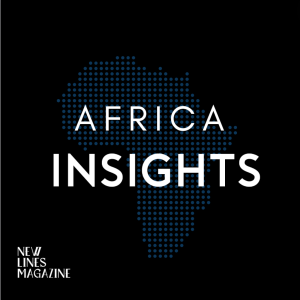Episodes

Tuesday Jan 16, 2024
Tuesday Jan 16, 2024
South Africa’s recent filing of a lawsuit in the International Court of Justice accusing Israel of committing genocide has sparked worldwide attention.
The case, which accuses Israel of committing genocide and war crimes in Gaza, has reignited discussions about South Africa’s post-apartheid history and its evolving position in the global political landscape.
Despite being celebrated for overcoming racism, South Africa has struggled with internal challenges, including sporadic and sometimes deadly violence targeting Black foreign nationals.
For more than three decades, foreign Black Africans have borne the brunt of widespread and recurring xenophobic attacks, with many having their businesses looted, while others have violently lost their lives.
The attacks stem from the belief that foreigners are to blame for South Africa’s social and economic woes. Many locals blame immigrants for taking their jobs and driving the unemployment level up.
“When we look at the statistics, when we look at the murder rate, the crime rate, we see that ever since Black foreigners were allowed to come to South Africa from independence, when we got freedom in South Africa, the crime rate has gone down by over 300%,” Rutendo Matinyarare tells New Lines’ Kwangu Liwewe.
Another aspect of the rise in xenophobia is belief in South Africa’s exceptionalism. This sense of exceptionalism has led many to see themselves as superior to the rest of the continent, which has led to widespread anti-immigrant sentiments and attacks.
“The thinking that was entrenched during apartheid was that South Africa is exceptional, that we are an exception and not like other African countries, as if we are not part of Africa,” Ntsikelelo Breakfast tells New lines.

Friday Jan 12, 2024
Friday Jan 12, 2024
Can France be fixed? The beleaguered nation faces crumbling institutions, civil strife and economic stagnation. But despite deep political divisions, the French public still seem to agree on one thing at least: something has gone very wrong. In her new book, “Fixing France: How to Repair a Broken Republic,” French journalist Nabila Ramdani digs deep into the nation’s history in search of the answers.
“There is this great dichotomy at the heart of the French Republic that stems from its very constitution,” she tells New Lines magazine’s Faisal Al Yafai. “France is built on impossible idealism, born out of revolutions, and this is why myths are so important for holding it together.”
Of course, there’s nothing unique about having a national mythology. All nations do, to some extent. But France stands out for its persistent consecration of those ideals in public life— “a glorious republic, built on high ideals of liberty, equality, and fraternity for all,” as Ramdani puts it — even as those promises seem increasingly thin and misguided to many of its people.
“That’s why the country is in such a crisis, because millions of French citizens are far more pragmatic than that,” she explains. “There's a massive gulf between France, the myth, and France, reality. And they are very different worlds indeed.”
Though Ramdani’s critique is broad, drawing on a wide range of political, historical and cultural factors — an all-powerful president, paramilitary policing, postcolonial anxiety and anti-immigrant xenophobia all among them — that gulf, she believes, may lie at the heart of all of them. Yet the country’s elite still cling to the myth, even as increasing numbers of French citizens conclude that the system is no longer working for them.
“That's really what my book is about. It's about state institutions that are outdated. It's about the Paris establishment that is looking after its own interests,” she says. “As former president Charles de Gaulle himself said, France is a perpetual illusion and it's very hard to reform.”
Produced by Joshua Martin
Friday Jan 05, 2024
Friday Jan 05, 2024
Iran was set ablaze last year after Mahsa Amini was taken into custody and beaten to death by the country’s morality police in Tehran for wearing “improper hijab.” The killing of the 22-year-old struck a deep chord among Iranians, inspiring protests in more than 100 cities throughout the country, marking the largest uprising Iran had seen since the 1979 revolution. Government reprisals were severe, with hundreds if not thousands of protesters arrested and tortured and several of them executed.
“The volume of art and creative responses that we've seen to this uprising is really unprecedented,”says Nahid Siamdoust, author of “Soundtrack of the Revolution: The Politics of Music in Iran” and host of the podcast “Woman, Life, Freedom.” “Even in comparison to 1979, I think this is unprecedented.”
“In a sense, the ‘Woman, Life, Freedom’ revolution is a revolution that's formed by culture, by art, by music, by poetry,” Malu Halasa, literary editor of The Markaz Review, tells New Lines magazine’s Danny Postel. It’s that art that is the subject of her new book, an edited anthology titled “Woman, Life, Freedom: Voices and Art from the Women's Protests in Iran,” which was released this month.
Unlike previous, more reformist protest movements in Iran, the Mahsa Amini protests became genuinely revolutionary. That revolutionary feeling was channeled into a great range of art forms, but especially music and hip-hop in particular. “Hip-hop in the West has lost its power. We haven't really had conscious rap for quite a long time,” Halasa says. But in Iran, she adds, “even before the ‘Woman, Life, Freedom’ movement, hip-hop was very powerful. It was critical of the status quo. It wasn't just party music.”
Artists can pay a high price for speaking out against the regime. For his blistering lyrics in support of the movement, a 32-year-old rapper from Esfahan named Toomaj Salehi was arrested and eventually sentenced to six years in prison after being held in solitary confinement for 252 days. He is one of many artists who have become figureheads of the wider movement, his songs played at protests while demonstrators wield placards with his name and face.
It’s no accident that musicians have become such integral and iconic parts of the movement, Siamdoust says. “Music is still strictly regulated. Dance is certainly not permitted on the streets,” she explains, “I think it is because of the imposition of these rules that opposition necessarily takes this form.”
Produced by Joshua Martin. This episode originally aired September 22, 2023.

Tuesday Jan 02, 2024
Tuesday Jan 02, 2024
In October 2023, during his inaugural visit to a Commonwealth nation as monarch, King Charles III conveyed his remorse to Kenyans for the violence inflicted by the British before the country gained independence.
Many elderly Kenyans were mistreated, raped and tortured by British colonial forces during the Mau Mau uprising (1951-1960). Kikuyu tribe members were held in detention camps that have been called “Britain’s gulag,” where they faced systematic torture and severe sexual assault.
However, during his recent visit Charles did not offer an apology. Such a step would take his country into “difficult legal territory,” said Neil Wigan, the British High Commissioner to Kenya, during the state visit.
“An apology shows that you have acknowledged and accepted that something very wrong was done,” Kenyan author and producer Salim Amin tells New Lines. “In terms of the country moving forward, for the Mau Mau fighters still alive, for them being apologized to would vindicate some of the things that happened to them.”
Charles’ acknowledgement follows a succession of European leaders who have recently spoken about their nations’ historical responsibilities for past abuses in their former colonies.
Denmark, France and the European Parliament have officially recognized past wrongs. Germany recently apologized to Tanzania two years after they also apologized for a genocide against the Herero and Nama tribes in Namibia.
There is undoubtedly a growing awareness of past abuses by the former colonial powers prompting them to come to terms with the past. Whether China and Russia’s growing influence on the continent is the driving factor, or societal pressures and demands for justice and reconciliation, still needs to be determined.
“It's certainly not pure realpolitik behavior and it’s certainly not pure altruism either, and it isn’t some sort of deeply felt effort to apologize for past atrocities either,” Brooks Spector, a former U.S. diplomat in Africa and East Asia, tells New Lines.
Africa Insights is hosted by Kwangu Liwewe and produced by Patrick Hagan.

Friday Dec 29, 2023
Friday Dec 29, 2023
“On the 7th of October I was on my way to a day out in the north of England with my family when I opened a news feed and found out that things are kicking off between Israel and Gaza,” Sharone Lifschitz tells New Lines magazine’s Joshua Martin. “My parents live about a mile from Gaza. I called my mom, and she didn't answer.”
By the evening, it had become clear that her parents were among the hostages kidnapped by Hamas. Her mother, Yochaved Lifschitz, was freed 16 days after the attacks, and images of her handshake with her former captor flashed around the world. Her father, Oded, remains in Hamas captivity. “So we are continuing to speak to whoever would listen in government and in media and try to advocate for their return.”
With over 200 hostages still in captivity in Gaza, it’s a nightmare she is far from alone in experiencing. “There's not one family who has not been affected,” she says. And yet many of those affected say that the Israeli government has all but abandoned them.
“The truth is that not only has the government not been forthcoming with them, but it's not clear what the government is doing, if anything, to get these hostages back,” says Noga Tarnopolsky, an Israeli journalist based in Jerusalem. “And so these families feel forsaken and abandoned.”
In the face of such apparent official indifference to their plight, some of the families have advocated for a bold proposal: everyone for everyone. In other words, release all of the Palestinians in Israeli detention — a number that has grown dramatically since the war began — in exchange for the hostages. “I am for everything that works,” Lifschitz says.
Tarnopolsky is more skeptical. “The offer has never been made in any way by Hamas,” she says. “I think that if this were a real offer, I think that the clamor for it would be so intense that the government would at least have to consider it.”
But such a prisoner swap remains the only real hope in the eyes of many of the families, who continue to push for it in the face of apparent government indifference. It may also be the only hope for some Palestinian detainees, many of whom are held without charge — and, according to civil rights groups, face serious human rights abuses in prison.
Since Oct. 7, Muzna Shihabi, a former adviser to the PLO negotiation team says, “according to Palestinian officials, the number has doubled.” Many, she says, report that their treatment has become even more severe over the past month.
But as long as Israel and Hamas remain as unwilling to negotiate as they currently seem to be, their plight — like those of the Israeli, Thai and other nationals held in Gaza — is unlikely to end anytime soon.
Produced by Joshua Martin. This episode originally aired November 10, 2023.

Friday Dec 22, 2023
Friday Dec 22, 2023
This year saw some major developments on the topic of Unidentified Anomalous Phenomena, or UAPs, also known as UFOs. Among these developments was the testimony of David Grusch, a career intelligence officer turned whistleblower, before Congress in July. He alleged that multiple United States defense and intelligence agencies had been illegally engaged in a secret “multidecade UAP crash retrieval and reverse engineering program;” that some of these crashed UAPs were piloted by “biologics” who were “nonhuman,” who are currently in U.S. custody; and that when he pressed the right authorities for more transparency on these programs, as he had been mandated to do by Congress, he was denied access and retaliated against.
This month, U.S. lawmakers, including those who have heard hours of additional testimony behind closed doors from Grusch and other former and active duty military and intelligence professionals, passed a bill that, for the first time, mandates the declassification and release of UAP records held by government agencies.
The bipartisan bill was co-sponsored by Senate Majority Leader Chuck Shumer and Sen. Mike Rounds, a Republican, and was passed in the Senate without resistance. But when it landed in the House, several Republican lawmakers demanded the removal of two key provisions.
In this episode, renowned civil rights lawyer Daniel Sheehan, who has been on the forefront of pushing for this legislation, joins Rasha Elass to talk about how we got here, why important provisions in the bill were removed and what we can expect moving forward, as lawmakers continue to push the government to disclose what it allegedly knows about nonhuman technology.
Produced by Rasha Elass and Patrick Hagan

Tuesday Dec 19, 2023
Tuesday Dec 19, 2023
The plight of illegal immigrants seeking asylum in the United Kingdom remains uncertain following Prime Minister Rishi Sunak’s latest legislation, which aims to send them to Rwanda to process their applications. Former Prime Minister Boris Johnson set the U.K.-Rwanda deal in motion in April 2022, with the intention of deterring immigrants from crossing the Channel in small boats or inflatable dinghies. The plan has been contested by several human rights organizations, with both the U.K. Appeals Court and Supreme Court deeming it unlawful. Sunak’s bill comes a month after the Supreme Court ruled that Rwanda is not a safe third country. The bill aims to overrule domestic and international court rulings that would block the deportation of asylum-seekers. “There’s something distasteful about this, it’s morally repugnant. It also means Britain would be in danger of violating the refugee convention in all sorts of international agreements,” British Journalist Michela Wrong tells New Lines’ Kwangu Liwewe. In response to the Supreme Court ruling, the Rwandan government has maintained that they are offering a home and safety to the asylum-seekers. However, opinions on Rwanda’s safety vary depending on who is asked. “Currently, Rwanda is a very unstable country involved in wars in Congo, and you pick people from the U.K. and you take them to Rwanda by force. These people are not going to Rwanda out of their own accord,” Rwanda’s former head of intelligence, Kayumba Nyamwasa, tells New Lines. More than 240 million pounds ($304 million) has so far been paid to the Rwandan government toward the deal, although so far no one has been deported to Kigali. “Since none of them have actually moved to Kigali or flown there, why has all that money already been transferred and why has it already been spent is really a mystery,” says Nyamwasa.

Friday Dec 15, 2023
Friday Dec 15, 2023
This fall, New Lines published a series of investigations digging into government cover-ups and abuses of power around the world. This week, The Lede goes behind the scenes of two of these investigations — one in Afghanistan and one in Nigeria — and shows the difference journalism can make in people’s lives.
“It kind of came into my head years ago, really, when I went back to Afghanistan in 2019,” journalist Lynzy Billing tells New Lines magazine’s Amie Ferris-Rotman. Large numbers of American service personnel had been diagnosed with health problems caused by the improper disposal of toxic waste on military bases. Nobody seemed to be asking an obvious question: What about the local people?
“You could visibly see the pollutants and the waste that these bases were producing,” Billing explains. “You could see all of this waste coming out in trucks every day. You could see the smoke from the burn pits.”
Billing used freedom of information requests to find out more about the kinds of contaminants that had come from the bases. At the same time, she began to visit local people who had lived near the bases during the American occupation. “I started to see the same health problems that you see U.S. service members coming down with, after they've returned from deployment,” she says. “You would have whole families that have the same health problems — kidney problems, heart problems, gastrointestinal problems, skin ailments.”
Since the Americans left, however, any real accountability seems a distant prospect. “All of this is happening because it was just allowed to happen, right?” Billing says. “There really is nothing that the U.S. has to do to clean it up. So for me, it was very clear from the very beginning that we needed to tell these stories.”
On another continent, Nigerian journalist ‘Kunle Adebajo heads the investigations desk at HumAngle. “I started reporting on the Boko Haram crisis in 2020,” he tells New Lines magazine’s Erin Clare Brown. “And so I've done lots of stories in the past about how people have been victimized by this crisis. But when I started reporting about missing people, I realized that it was a different ballgame entirely.”
Nigeria’s war against Boko Haram, an insurgent group affiliated with Islamic State, left tens of thousands of people missing. State forces treated the local civilian populations brutally, with mass arrests and extrajudicial killings rife. But these abuses went mostly unrecorded. “People could not confirm the status and whereabouts of people who were arrested,” Adebajo says. “And that means even if your family member is dead, there's no way for you to know for certain.”
In collaboration with New Lines, Adebajo and his team set out to investigate. Combining local reports with satellite data, they were able to uncover a number of mass graves left by the Nigerian army. The army didn’t respond directly to their request for comment, he says, but just weeks afterward, some of the families began to get phone calls from their missing loved ones. They’d been held in detention for years without contact with the outside world, but because of the increased scrutiny from the investigation, the government was finally allowing them to contact their relatives.
“Hundreds of people had received phone calls,” Adebajo says. “The estimate at the time was about 200. And the calls kept coming in.”
Produced by Erin Clare Brown and Joshua Martin

Friday Dec 08, 2023
Friday Dec 08, 2023
“I grew up in a time where history in a way was taught primarily in the aftermath of the Second World War,” Lebanese sculptor Rayanne Tabet tells New Lines magazine’s Rasha Elass. “But I became convinced that our contemporary condition is really led by these moments in the 19th century, where language around the creation of nations, language around cultural property, language around history, really developed.”
Such big ideas are the inspiration for Tabet’s art, and his 2020 ‘Arabesque’ exhibition, shown all around the world, is no different. The term “Arabesque,” he explains, “comes from the Italian called Arabesco, which means ‘in the Arab style” but also extended to describe things that were foreign. So a shape that one could not understand or a movement that went beyond the standard form or even a sound that sounded maybe different.”
The expedition features fragments from 19th-century Orientalist manuscripts, cut out from their original contexts and rearranged into something new — “to deconstruct it and in a way to appropriate it, right?” Tabet says. “Confronting this past, not by negating it or destroying it, but by using the very tools it developed to figure out a way to reimagine it.”
It’s a recurring theme in Tabet’s art, which explores the nooks and crannies where history, politics, architecture and aesthetics intersect. “I think that within the tools that we have at our disposal or can help us challenge the very system that has created these tools,” he says.
For instance, the aesthetics of modernity — “clean, white, without ornament, without any decoration,” as he puts it. That style, he says, “came hand in hand with political doctrines that introduced this idea that modernity means the erasure of our own indigenous styles.”
“That has always been at the center of my work,” he reflects. “Trying to come to terms with the beauty, the elegance, but also the tragedy and the violence at the center of the creative process.”
Produced Joshua Martin

Tuesday Dec 05, 2023
Tuesday Dec 05, 2023
Africa Insights is a podcast special from New Lines magazine exploring Africa's unique stories from an African perspective.The ongoing conflict between Israel and Palestine continues to send reverberations across the globe. In Africa, South Africa stands out as the leading voice, strongly supporting Palestine despite facing criticism from factions in its own Jewish community, opposition parties and faith-based parties.
Historically, South Africa’s ruling African National Congress (ANC) has been a longtime supporter of the Palestinian cause, often likening it to the apartheid era, which was a system of institutionalized racial segregation and discrimination against the black majority and other nonwhite ethnic groups in South Africa.
The Israel-Palestine conflict has further split an already divided country still grappling with racial and ideological divisions.
“We can’t just look at Palestine and Israel without an appreciation of the South African context. So, when Jewish members of the synagogues which are largely if not exclusively white filter their hegemonic presence of a Zionist state in Israel, they filter this through their white consciousness,” the Rev. Michael Weeder, dean at St. George's Cathedral in Cape Town, tells New Lines’ Kwangu Liwewe.
The Jewish community in South Africa, which to a large extent supported the anti-apartheid movement, is divided over the conflict, with some reflecting on what the struggle in South Africa was able to achieve for minority groups.
“The community is extremely split. There probably is some understanding in the broader Jewish community that South Africa was able to address the issue of African majority and cede power and become a democracy,” says Jonathan Shapiro, a South African political cartoonist.
On the political front, the ANC-led government’s stance has been criticized for its tepid response to the Oct. 7 attacks. Ten days after the attack, South Africa’s Foreign Minister Naledi Pandor held a call with Hamas leader Ismail Haniyeh, which ignited fury among supporters of Israel within the country.
“From the ANC government there’s been sort of a fairly lukewarm condemnation of Hamas,” Shapiro says. The biggest difficulty amongst progressive and more radical Jews is how to approach what Hamas did on Oct. 7. There are Jews who won’t sign certain petitions, who won’t take a position as strongly opposed to what Israel is doing because they feel that there's too little condemnation.”





